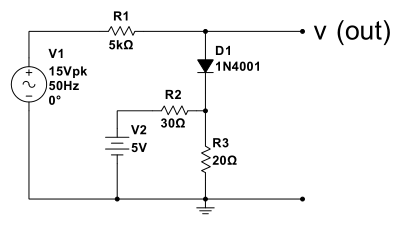Let's start by analyzing your third circuit (the first is just a generalized concept, and the second makes no sense at all). R2 and R3 form a voltage divider. The output is (20 Ω)/(50 Ω) = 0.4 of the input. Since the input is 5 V, the output is 2 V. That's what the cathode of D1 will be at when D1 is not conducting. At this point, remember what Thevenin said and realize this is just a 2 V source with 12 Ω impedance.
Let's say the forward drop of D1 is 700 mv. That means D1 starts to conduct when its anode, which is also Vout, is 2.7 V. If we make the simplifying assumption that the diode is a fixed 700 mV voltage source when on, then its anode looks like a 2.7 V 12 Ω source when Vout is 2.7 V or above.
Any part of V1 above 2.7 V will be attenuated by the 5 kΩ and 12 Ω voltage divider, which has a gain of (12 Ω)/(5012 Ω) = 0.00239. For example, when V1 goes to 3.7 V, the part above 2.7 V will result in only 2.39 mV rise. Vin of 3.7 V therefore results in Vout of 2.704 V.
So yes, this circuit can be considered a clamp, since it greatly attenuates voltages above a certain level.
However, in most cases these circuit are not desirable. You are spending a lot of power to make the 2 V 12 Ω voltage source. The total current thru R2 and R3 even when not clamping is (5 V)/(50 Ω) = 100 mA. That is unacceptably large in many circumstances.
R2 will dissipate 300 mW and R3 will dissipate 200 mW. That rules out ordinary 0805 resistors. R2 can't even be a "1/4 W" resistor, and that would be cutting it close for R3.
Here is a better way to make a clamp using a similar concept:

The basic difference is that the diode is replaced by a transistor. In this case, think of the transistor as a diode with gain. Current will flow thru the E-B junction like it did the diode before. However, for every one unit of current flowing out the base, there will be gain units of current flowing out the collector. The clamping current draining Vout is the total, but the voltage divider is only loaded with the much smaller base current.
In this example, R2 and R3 are 10x higher. That means they require 10x less current from V1, but also that they have 10x more impedance. However, due to the gain of Q1, the apparent impedance at the emitter is gain+1 times lower than the impedance at the base. Therefore, the transistor only needs to have a gain of 9 for this to clamp the same as your circuit, but with 10x less V1 current. Small signal transistor gains can be over 100, so in reality the resistors can be increased further and still perform as well as your circuit, but with much less quiescent current.
In a real circuit, I'd add a cap across R3. That makes the clamp even lower impedance for short term spikes.




